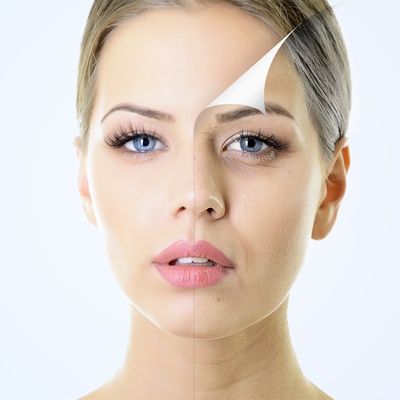Bell's Palsy
Bell’s palsy, commonly referred to as BP, is a disorder that leads to temporary weakness of your facial muscles. This condition causes one side of the face to become stiff or droop. As one of the most respected Bell’s palsy specialists in New Jersey & NYC, Dr. Monica Tadros evaluates and effectively treats this facial disorder in a friendly and compassionate environment. Dr. Tadros is proud to be the number one choice for patients looking for highly effective facial paralysis treatment in NJ.
What is Bell's Palsy?

Bell’s palsy is a form of temporary facial paralysis that results from injury or damage to one of the facial nerves and can cause significant facial distortion.
Dr. Monica Tadros specializes in Bell's Palsy and facial paralysis treatment. Disorders of the facial nerve, including paralysis, develop from a variety of causes. Abnormal movement or paralysis of the face can result from infection, injury, or tumors, and an evaluation by your physician is needed to determine the cause.
Dr. Tadros has advanced training and extensive experience in managing the full range of facial nerve disorders for her patients.
Dr. Tadros accepts most POS and PPO insurance for any medical issues as an out-of-network provider. Please contact us today or call NYC: (201) 408-5430 or NJ: (201) 408-5430.
Bell's Palsy & Facial Paralysis In Depth
by Monica Tadros, M.D., F.A.C.S.
What Is the Facial Nerve?
The facial nerve resembles a telephone cable and contains about ten thousand individual nerve fibers. Each fiber carries electrical impulses to a specific facial muscle. Information passing along the fibers of this nerve allows us to laugh, cry, smile, or frown, hence the name, "the nerve of facial expression."
Among the most complex nerves in our body, the facial nerve is central to our ability to manipulate our expression in countless ways, adding layers of emotion to the way we communicate. When there is nerve damage, facial weakness occurs. If these nerve fibers are irritated, then movements of the facial muscles appear as spasms or twitching.
The facial nerve not only carries nerve impulses to the muscles of the face but also to the tear glands, to the saliva glands, and to the muscle of the stirrup bone in the middle ear (the stapes). It also transmits taste from the front of the tongue.
Since the function of the facial nerve is so complex, many symptoms may occur when the fibers of the facial nerve are disrupted. A disorder of the facial nerve may result in: twitching, weakness, or paralysis of the face, such as Bell's Palsy dryness of the eye or the mouth or even disturbance of taste.
Bell's Palsy and Other Causes of Facial Weakness
The most common cause of facial weakness, which develops suddenly, is referred to as "Bell's palsy." The etiology of this disorder is unknown but is probably due to the body's response to a virus: in reaction to the virus, the facial nerve within the ear (temporal) bone swells, and this pressure on the nerve in the bony canal damages it.
In order to diagnose facial nerve disorders and determine the cause of facial weakness, a special set of questions will be asked. After an examination of the head, neck, and ears, a series of tests may be performed.
The most common tests include:
- Hearing Tests: Determine if the cause of damage to the nerve has involved the hearing nerve or inner ear.
- Imaging: CT (computerized tomography) or MRI (magnetic resonance imaging) may determine if there is an infection, tumor, bone fracture, or other abnormality in the area of the facial nerve
- MRI is the gold standard for the diagnosis of facial nerve disorders; CT scans are used in cases of mass lesions or trauma.
- Electrical Tests: By stimulating the facial nerve, electrical tests can be used to assess how badly the nerve is damaged. They include Nerve Excitability Test (NET) to determine the extent of nerve fiber damage in the case of total paralysis. If the test is normal despite paralysis, this may suggest a higher chance of recovering function. Electroneurography (ENoG) uses electrodes placed on the face and a small current to stimulate the facial nerve. During stimulation, a computer measures the muscular response. Electromyography (EMG) is an electrical test that measures the muscles during rest, during voluntary movements, and during electrical stimulation. It is used to determine if the nerve and muscles are recovering. These tests may be repeated at frequent intervals to monitor Bell's palsy recovery.
Treatments for Bell's palsy and Facial paralysis Disorders
The standard of treatment for Bell's palsy and facial paralysis in NJ is to treat the cause. Our facial plastic surgeons work with our patients to accurately determine the cause of the disorder and prescribe the best facial paralysis treatment for the condition. For Bell's palsy syndrome, the usual regimen includes steroids and antiviral medications. Surgical decompression and rehabilitative procedures, including gold weights and reanimation surgery, may also be appropriate.
If the infection is the cause, then an antibiotic to fight bacteria (as in middle ear infections) or antiviral agents (to fight syndromes caused by viruses such as Bell's Palsy or Ramsay Hunt) may be used. If simple swelling is believed to be responsible for the facial nerve disorder, then steroids are often prescribed.
In cases of trauma or for some patients with Bell's palsy, surgical removal of the bone around the nerve (decompression) may be necessary.

Protecting the Eye in Facial Nerve Disorders
When the facial nerve is paralyzed, considerable attention must be given to maintaining a healthy eye, which requires a constant flow of tears. These tears are spread out over the eye by blinking, but blinking is diminished or eliminated in facial nerve paralysis. Diminished blinking and the absence of tearing together can reduce or eliminate the flow of tears across the eyeball, resulting in drying, erosion, and ulcer formation on the cornea, and possible loss of the eye.
The eye is kept moist initially with artificial tears during the day and ointment at night. It may also be taped shut. When weakness is profound and/or prolonged, the cornea may be exposed and at risk for exposure keratitis. In these circumstances, a gold weight may be placed. Gold weight insertion is a simple, reversible procedure that may be performed in the office setting to provide effortless eye closure and protection.
Alternatively, Dr. Tadros has pioneered a technique of using injectable hyaluronic acid filler to simulate a gold weight for patients where recovery is still uncertain. This non-surgical option is rapidly reversible in the office upon return of eyelid function.
Complex eye disorders may result from prolonged paralysis, including chronic tearing, lower lid laxity, and ectropion. A number of corrective procedures are available to treat these conditions and protect the delicate eye area.
Rehabilitation from Facial Nerve Disorders
Best face surgeon offers the most advanced medical therapies to treat the individual etiologies of early facial paralysis to swiftly optimize potential recovery. In circumstances of permanent paralysis, alternative treatments must be tailored to the individual on the basis of etiology, duration/ location of paralysis, and degree of weakness.
Patients with permanent facial paralysis may be rehabilitated through a variety of surgical procedures, including gold eyelid weights, orbital reconstruction, nasal airway repair, muscle transfers, and nerve substitutions.
Other medical treatments for complications of facial paralysis including excessive motion of the face or muscle spasm and may involve surgical division of overactive muscles or weakening them by chemical injection using small amounts of BOTOX®.
The significant emotional and psychological issues that often accompany disorders of the face are especially significant in cases of paralysis where patients cannot smile or adequately convey their emotions. The impact of this for both the patient and family is devastating and should not be underestimated. Behavioral changes limiting public exposure or display of emotion should be discussed openly and highlight the importance of rehabilitation.
Check out Theresa's Story:
What Is the Prognosis for Bell’s Palsy?
Overall, this condition has a fair prognosis without treatment. Noticeable improvements occur within the first 3 weeks in 85% of people and within 3 to 6 months in the remaining 15%. Patients that do not experience any signs of improvement by three weeks might have experienced severe degeneration of the facial nerve or might have an alternative diagnosis.
According to research on Bell's palsy, published on NCBI, approximately 71% of patients experience complete recovery in facial muscle function. The remaining 29% have permanent mild to severe residual facial muscle weakness.
Incomplete recovery of facial expression can negatively affect the quality of life and self-esteem. Bell’s palsy prognosis for children is much better, accounting for a 90% rate of spontaneous recovery. This occurs because of the higher frequency of paresis.
About Dr. Monica Tadros

Dr. Tadros is a distinguished Facial Plastic Surgeon & Reconstructive Surgeon, and Educator.
She is one of a small number of surgeons to attain dual board certification in Otolaryngology-Head & Neck Surgery and Facial Plastic & Reconstructive Surgery and has combined the two specialties in her unique practice of aesthetic medicine.
Dr. Tadros has received numerous awards and accolades for her forward-thinking teaching and innovations in Aesthetic Facial Surgery. She was appointed the Director of Facial Plastic & Reconstructive Surgery and Asst. Professor of Otolaryngology-Head & Neck Surgery at the prestigious Columbia University in 2006, where she taught many generations of residents and medical students.
Frequently Asked Questions
Bells Palsy affects the facial nerves and creates paralysis or weakness of the muscles on one side of the face. Below are some commonly asked questions about Bell’s palsy.
What Causes Bell’s Palsy?
One of the most common Bell's Palsy causes is an inflammation of the nerves that control one side of your face. It can also be caused by the same viral infection that causes cold sores. Idiopathic facial paralysis can also be triggered by stress. Symptoms usually go away on their own after some time but may come and go.
Other common causes of facial palsy include:
- Tuberculosis
- Trauma
- Sarcoidosis
- Vasculitis
- Neoplasm
- HIV (Human Immunodeficiency Virus)
Is Bell’s Palsy Contagious?
BP disease is not contagious. However, if it is caused by a viral infection, such as cold sores or herpes, the underlying cause can be transmitted to another person. People with migraines are at a higher risk for Bell’s palsy. Pregnant women in their third trimester also have a higher likeliness to get facial nerve conditions.
How Long Does Bell’s Palsy Last?
Bell’s palsy treatment results typically last 2 weeks. People usually fully recover in about 6 months. The duration of the disease depends on the individual. In some people, the symptoms may never fully disappear. You can get rid of it with some facial paralysis treatments such as steroid injections, antiviral medicine, or physical therapy.
What Are the Symptoms of Bell’s Palsy?
Bell’s palsy symptoms include sudden weakness in one side of the face. Onset is usually quick, from an hour to a couple of days. Idiopathic facial paralysis causes facial drooping and possible drooling. Sometimes you may feel pain in the affected side of the jaw. Other symptoms include headaches, loss of taste, and excessive tears or saliva.
What Are the Potential Side Effects of Bell’s Palsy?
Most people suffering from this condition recover completely without complications. However, some patients with severe cases of this disorder may still experience certain side effects.
Most common Bell’s palsy side effects and complications include:
- Contracture of facial muscles
- Loss of taste sensation
- Issues with dysarthria because of facial muscle weakness
- Incomplete recovery
- Crocodile tears. Tears occur due to misdirection of regenerating gustatory fibers destined for the salivary glands.
- Motor synkinesis. Involuntary movement of muscles that occurs simultaneously with deliberate movement.
Dr. Monica Tadros, as a leading specialist in the field of Bell’s Palsy treatment in NJ, takes all the necessary actions to ensure the effectiveness of the treatment without any side effects. Her enormous experience allows her to provide the facial paralysis treatment that entails no complications.
Consultation
Interested in learning more about Bell's palsy and facial paralysis treatment? Please contact Dr. Tadros at Plastic Surgery Center in NYC: (201) 408-5430 or NJ: (201) 408-5430 to schedule your consultation.
Dr. Tadros believes that the initial consultation is most important and should be done face to face with your surgeon. After listening closely and carefully to your concerns, Dr. Tadros is able to do a critical evaluation and make the correct recommendations to address your specific needs for your Bell's palsy and facial paralysis treatment in NJ.
